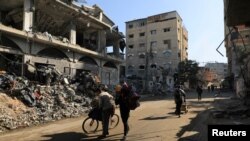The opening of a potential new battle zone points to the long and destructive road still ahead as Israel vows to crush Hamas after its October 7 attack on southern Israel. For weeks, Israeli forces have been engaged in heavy urban fighting in northern Gaza and in the southern city of Khan Younis, driving Palestinians into further smaller corners of territory in search of refuge.
Despite international pressure for a cease-fire and U.S. calls for a reduction in civilian casualties, Israeli Prime Minister Benjamin Netanyahu on Monday warned that the fight “isn’t close to finished.”
Israel’s offensive has been one of the most devastating military campaigns in recent history. More than 20,600 Palestinians, two-thirds of them women and children, have been killed, according to the Health Ministry in Gaza, which does not differentiate between civilians and combatants among the dead.
Meanwhile, there were new signs of the Israel-Hamas war enflaming tensions around the region. An Israeli airstrike in Syria killed an Iranian general, bringing vows of revenge from Iran. U.S. warplanes hit Iranian-backed militias in Iraq who had carried out a drone strike that wounded American soldiers there.
Residents of central Gaza on Tuesday described a night of shelling and airstrikes shaking the Nuseirat, Maghazi and Bureij camps. The camps are built-up towns, housing Palestinians driven from their homes in what is now Israel during the 1948 war and their descendants — and now also crowded with people who fled from the north.
“The bombing was very intense,” Radwan Abu Sheitta, a Palestinian teacher said by phone from his home in Bureij. “It seems they are approaching,” he said of the Israeli troops.
The Qassam Brigades, Hamas’ military arm, said its fighters struck an Israeli tank east of Bureij. Its report could not be independently confirmed, but it suggested Israeli forces were moving toward the camp.
Warplanes and artillery also hammered areas east of Nuseirat camp. “We couldn’t sleep because of the bombing,” said Ezzel-Din Mohammed Abdallah al-Masry, a Palestinian fisherman who was displaced to the area from northern Gaza with his five children and other family. “The children are terrified. We are terrified.”
Gaza fighting
Israeli troops have been engaged in nearly two months of ground combat with Hamas and other militants in northern Gaza and weeks of urban fighting in Khan Younis. The battles and bombardment have leveled large swaths of both areas, and strikes have continued across the territory.
Still, Hamas fighters have shown a tough resilience. The Israeli military announced the deaths of two more soldiers Tuesday, bringing the total killed in the ground offensive to 158. Militants late Monday launched a barrage of rockets into Israel, triggering air raid sirens in the southern city of Ashkelon. There were no immediate reports of damage or injuries.
Israel has vowed to continue fighting to eliminate Hamas’ military and governing capabilities in Gaza, after the militants carried out their shock attack into southern Israel on October 7, killing around 1,200 people, mostly civilians, and taking some 240 hostage. Israel says it also aims to free the more than 100 hostages who remain in captivity in Gaza.
Israel faces international criticism for the civilian death toll. It blames Hamas, citing the militants’ use of crowded residential areas and tunnels. Israel says it has killed thousands of Hamas militants, without presenting evidence.
In Khan Younis, the Palestinian Red Crescent said Tuesday morning its medics evacuated several dead and wounded after a house in the city’s al-Amal neighborhood was bombed overnight. In nighttime footage posted by the charity, first responders and residents pulled a dead person from the rubble, using lights from mobile phones.
An Associated Press cameraman on the scene saw at least two dead and 15 wounded, mostly children.
The expanding fighting has pushed the population into a shrinking area, particularly the central city of Deir al-Balah and Rafah, at the far south of Gaza on the Egyptian border. More than a million people have squeezed into U.N. shelters, and many more displaced people are crowded into houses.
U.N. officials have warned that a quarter of the population is starving under Israel’s siege of the territory, which allows in only a trickle of food, water, fuel, medicine and other supplies.
The U.N. Security Council last week called for immediately speeding up aid deliveries to desperate civilians in Gaza. But so far there has been little concrete sign of a change in entry of aid, which the U.N. has said it struggles to distribute because many areas are cut off by fighting.
Meanwhile, negotiations have seemed to make little headway toward a pause in fighting to allow the exchange of more hostages held in Gaza for Palestinians imprisoned by Israel.
Egypt has put forward an ambitious peace proposal aiming not only to end the war but also to lay out a plan for the day after. It calls for a phased hostage release and the formation of a Palestinian government of experts to administer the Gaza Strip and occupied West Bank, according to a senior Egyptian official and a European diplomat familiar with the proposal.
But it has gotten a cool public reception from Israel and Hamas. It falls short of Israel’s declared goal of crushing Hamas and appears to be at odds with Israel’s insistence on maintaining military control over Gaza for an extended period after the war. It is also unclear if Hamas would agree to relinquish power after controlling Gaza for the past 16 years.

Forum